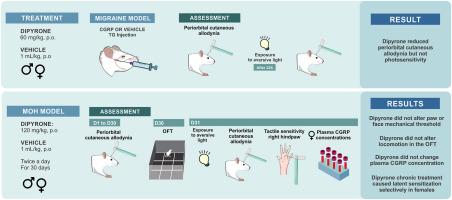在药物过度使用头痛的临床前模型中,双吡隆诱导性别依赖的潜在致敏。
IF 4.7
3区 医学
Q1 PHARMACOLOGY & PHARMACY
引用次数: 0
摘要
过度使用药物对症治疗原发性头痛可导致药物过度使用头痛(MOH),这是一种继发性慢性头痛。认为过量使用任何非处方镇痛药均可诱发MOH,但临床前和临床证据较少。本研究旨在评估雄性和雌性大鼠长期暴露于双吡酮(metamizole)是否会诱发MOH。首先,在三叉神经节注射降钙素基因相关肽(CGRP, 0.1 nmol/10 μL)诱导的偏头痛相关反应中,评估双吡酮(60 mg/kg)的急性效应。然后,动物口服双吡酮(120 mg/kg, 2 x天/30天),每隔5天评估一次眶周力学阈值。在治疗结束时,动物暴露在强光下进行异常性疼痛恢复。后肢区域的机械阈值、运动活动以及血浆CGRP水平也被评估。双吡隆单次给药可减轻CGRP引起的雌雄大鼠眶周机械异常痛。雄性和雌性大鼠经双吡酮治疗30天后,眶周力学阈值未见任何变化。然而,慢性双吡咯酮诱导潜在致敏,通过强光照射显示,选择性地在雌性中发生。长时间地吡酮治疗不影响足跖机械阈值、运动行为或血浆CGRP水平。这些结果表明,长期使用双吡酮治疗可引起三叉神经系统的致敏,并可能诱发MOH,女性更容易受到伤害。本文章由计算机程序翻译,如有差异,请以英文原文为准。

Dipyrone induces sex-dependent latent sensitization in a preclinical model of medication overuse headache
The excessive use of medications for the symptomatic treatment of primary headaches can lead to the development of Medication Overuse Headache (MOH), a secondary chronic headache. It is considered that the excessive use of any over-the counter analgesic can induce MOH, but there is little preclinical and clinical evidence. This study aimed to evaluate whether prolonged exposure to dipyrone (metamizole) in both male and female rats induces MOH. First, the acute effect of dipyrone (60 mg/kg) was assessed in migraine-related responses induced by injection of calcitonin-gene related peptide (CGRP, 0.1 nmol/10 μL) in the trigeminal ganglion. Next, the animals were orally treated with dipyrone (120 mg/kg, 2 x day/30 days) and the periorbital mechanical threshold was assessed at 5-day intervals. At the end of the treatment, the animals were exposed to a bright light for allodynia reinstatement. Mechanical thresholds in the hindpaw region, locomotor activity as well as plasma levels of CGRP were also assessed. A single administration of dipyrone reduced periorbital mechanical allodynia induced by CGRP in male and female rats. Male and female rats treated with dipyrone for 30 days did not show any change in the periorbital mechanical threshold. However, chronic dipyrone induced latent sensitization, revealed by bright light exposure, selectively in females. Prolonged dipyrone treatment did not affect the paw mechanical threshold, the locomotory behavior, or the plasmatic levels of CGRP. These results suggest that prolonged treatment with dipyrone can cause sensitization of the trigeminal system and potentially induced MOH, with females being more vulnerable.
求助全文
通过发布文献求助,成功后即可免费获取论文全文。
去求助
来源期刊
CiteScore
9.00
自引率
0.00%
发文量
572
审稿时长
34 days
期刊介绍:
The European Journal of Pharmacology publishes research papers covering all aspects of experimental pharmacology with focus on the mechanism of action of structurally identified compounds affecting biological systems.
The scope includes:
Behavioural pharmacology
Neuropharmacology and analgesia
Cardiovascular pharmacology
Pulmonary, gastrointestinal and urogenital pharmacology
Endocrine pharmacology
Immunopharmacology and inflammation
Molecular and cellular pharmacology
Regenerative pharmacology
Biologicals and biotherapeutics
Translational pharmacology
Nutriceutical pharmacology.

 求助内容:
求助内容: 应助结果提醒方式:
应助结果提醒方式:


